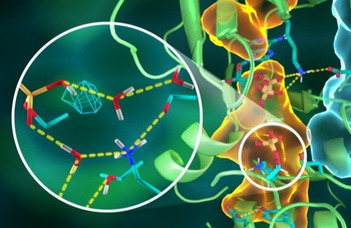Researching promiscuous proteins
Promiscuity, that is, changing sexual partners, is a well-known phenomenon in biology. But does it also exist in the world of molecules and proteins? Are there proteins that frequently change their molecular partners? We can give an affirmative answer to this question. László Nyitray, full professor at the ELTE Department of Biochemistry, and Tamás Martinek, full professor at the Institute of Medical Chemistry at the University of Szeged, and their research groups investigated promiscuity in the context of protein-protein interactions.
László Nyitrai and his colleagues previously studied twenty members of the S100 protein family, which is a young protein in the evolutionary sense and occurs only in vertebrates. These proteins bind calcium ions, which have a prominent regulatory role in cells. They can interact with other proteins, and, therefore, they are present in a large number of physiological and pathological processes. Pathological cases are always connected with the excessive production of S100 proteins. Due to its role in the development of metastasizing tumours, as well as neurodegenerative and inflammatory diseases, the S100 protein family has a major significance in diagnosis and therapy. The researchers explored the specificity of the protein family and discovered that
one part of the family is “promiscuous”, in other words, it interacts with several partner proteins,
while the other half of the family is “monogamous,” and only binds to one or a few partner proteins, or are orphans lacking known partners. They also found that without mapping the interactions of the S100 family, it would be impossible for them to proceed with their research.
It was at this point that they contacted Tamás Martinek at the University of Szeged, who with his research group was one of the first in the world to construct so-called foldamer libraries. Foldamers are synthetic structural elements imitating the participants of protein-protein interactions and are considered potent tools in drug development (especially in cases where specific binding to the target protein cannot be achieved with an organic small molecule). The Martinek group, in cooperation with the Nyitray group, among others, published a highly cited paper in the Journal of Chemical Biology on the usability of foldamers – namely that they can distinguish target proteins by function. This publication has been included in the 2020 Chemical Science HOT Article Collection by the prestigious chemistry journal above.
In their article published recently in Scientific Report, the researchers were able to map the binding surfaces of all members of the S100 protein family with the help of a molecular library consisting of hexameric foldamers “mimicking” binary natural amino acid side chain combinations. Moreover, they screened all the 256 possible combinations of 16 amino acids in two residues per foldamer building block, that is, they measured over 5000 binding affinities.
They are among the first scientists in the world to use the so-called holdup assay for a high number of measurements.
This method was originally devised by their collaboration partner Gilles Travé and his colleagues from France. The results were validated with the fluorescence polarization assay developed by the Nyitray group for previous studies. In addition, the high-throughput holdup assay also made it possible to calculate a “promiscuity value” for each S100 protein using a simple algorithm. A substantial part of the experiments presented in the report was carried out by Márton Simon, an awardee of the National Conference of Student Research Societies (OTDK) and two-time winner of the New National Excellence Programme (ÚNKP), master’s student in chemistry (currently a doctoral candidate at Semmelweis University).

The so-called heat map of the interaction between the S100 proteins (rows) and foldamers (columns). The darker a cell is, the stronger the binding measured with the holdup assay is.
The results partly supplement and partly confirm what was reported in the authors’ previous article, where they pointed out that approximately half of the S100 protein family is “promiscuous,” interacting with numerous partners (foldamers), while the other half establish physical contact with only one or two partners or none at all. The results above must be taken into account in the future development of inhibitors meant to eliminate the pathological role of S100 proteins so as to produce an effective medicine with the fewest possible side effects.
The research was supported by the research grants provided by the National Research, Development and Innovation Office and the National Programme for Protein Science and its Applications. Further figures related to the research can be viewed on the website of the ELTE Faculty of Science.

